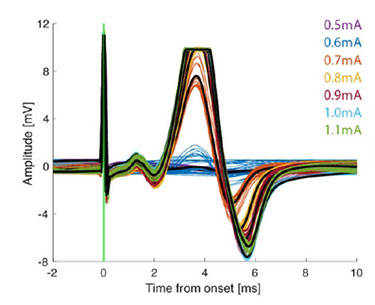
To mitigate this problem, researchers from UC Berkeley and UC San Francisco have developed electrodes based on silicon carbide (SiC), which hold promise of a long device lifetime...

The last decade has seen great progress in technologies for electrophysiological recording and stimulation. Translation of such devices from lab to clinic has been hindered, however, by the limited lifetime of the neural implants, which often fail after a few years due to electrode deterioration. To mitigate this problem, researchers from UC Berkeley and UC San Francisco have developed electrodes based on silicon carbide (SiC), which hold promise of a long device lifetime (J. Neural. Eng. 14 056006).
SiC offers many desirable characteristics: it is biocompatible, chemically inert, an excellent molecular barrier and compatible with standard microfabrication techniques. "The main reason these electrodes are long-lasting is the use of SiC," said first author Camilo Diaz-Botia. "Materials used in current technologies have been observed to degrade both in vitro and in vivo. This is problematic because electrical insulation fails as this degradation happens and high-quality recordings are lost."
Diaz-Botia and colleagues created an implantable electrode array that uses conductive polycrystalline SiC at the recording site and amorphous SiC (a-SiC) as the only insulation. They developed a process for depositing high-quality insulating a-SiC films using plasma-enhanced chemical vapor deposition at a wafer level – enabling high throughput fabrication of neural probes. Combining conductive and insulating SiC within the same device results in an electrode array whose exposed interfaces have seamless transitions between conducting and insulating regions of the same material.
"At the active sites, we use a combination of conductive and insulating SiC, which eliminates interfaces of heterogeneous materials exposed to the exterior of the electrodes," explained Diaz-Botia. "Such exposed interfaces are prone to failure due to delamination of the insulator." He noted that the fabrication process uses tools, materials and chemistries similar to those employed for silicon, allowing foundries to easily adapt their tools for SiC processing.
In vivo testing
To assess the performance of the SiC electrode array in the central nervous system, the researchers implanted a 64-channel array in the right primary visual cortex of an anesthetized rat. They measured the animal's neural responses to visual stimuli – sinusoidal gratings moving across a computer screen at various orientations.

Implanted SiC array and neural response
The researchers could easily observe neural activity in response to visual stimuli in the expected cortical regions. Sampling signals from the surface of the primary visual cortex revealed increases in gamma-band activity in all trials, with high enough signal quality that orientation tuning was clear in some cortical locations. In one example, the rat exhibited the strongest activity in response to stimuli orientated at 270° and 225°, and the smallest response to 45° and 180°. Control stimuli (a zero-contrast display) did not elicit any neural activity.
The team also used SiC electrode arrays to record response from the peripheral nervous system. The flexibility of the SiC electrode arrays enabled them to be securely wrapped around the sciatic nerve and record from multiple sites along the nerve trunk. Electrical stimulation – square pulses with amplitudes between 0.5 and 1.2 mA – was delivered via stainless steel needles to the biceps femoris muscle ipsilateral to the array.

Sciatic nerve response to electrical stimulation
Stimulation at 0.5 mA failed to elicit a strong enough compound action potential to be seen. At 0.6 mA, a compound action potential with small amplitude was observed 10% of the time. Stimulation at 0.7 mA or higher elicited a response every time the muscle was stimulated, with the amplitude of the compound action potential increasing in response to increasing stimulation amplitude, from 0.7 to 0.9 mA and saturating around 1 mA. Electrical stimulation of the contralateral muscle (performed as a control) elicited no response regardless of pulse amplitude.
Long-lasting insulator
To test the longevity of the insulating a-SiC, Diaz-Botia and colleagues subjected over 50 a-SiC films deposited on silicon wafers to accelerated aging (heating in PBS solution to up to 96°C). Films thinner than 150 nm were aged up to 24 h while those thicker than 150 nm were aged for up to 1600 h. Visual inspection showed that every aged film remained intact, with no colour change from a non-aged film (indicating no change in thickness).
In contrast, control samples of thermal oxide (SiO2) – one of the best insulators employed in microelectronics – appeared clearly etched, and in some cases the silicon carrier was completely exposed. "The big advantage that SiC has over SiO2 is that SiC is chemically inert, it doesn't dissolve in aqueous environments like SiO2 does," explained Diaz-Botia.
Leakage currents in thin a-SiC films were below 500 nA/cm2 at 96°C and remained constant for the entire experiment (suggesting that the a-SiC did not degrade), while leakage currents for control samples increased to about 2.5 A/cm2 within 3 h. When the a-SiC films were returned to room temperature, leakage currents returned to low levels. Thicker a-SiC films (360 and 450 nm) aged for several days also performed better than SiO2 controls.
The researchers note that thicker a-SiC films can be excellent electrical insulators with minimal leakage current: a 1000 nm a-SiC film maintained leakage currents of less than 1 nA/cm2 at high temperatures for up to 1600 h, while 1000 nm thermal oxide fails at about 200 h.
The authors concluded that SiC can be integrated into a fully implantable neural interface and will likely remain stable for several decades. Next, they plan in vivo chronic experiments to determine the technology's lifetime limits. "A second goal is to expand the use of insulating SiC coatings to other devices beyond neural probes," Diaz-Botia told medicalphysicsweb.